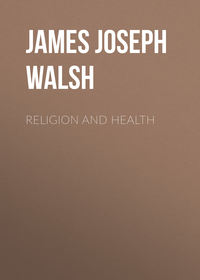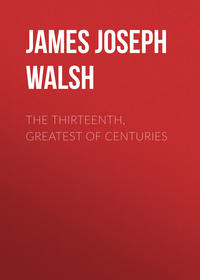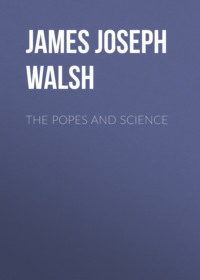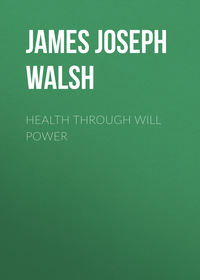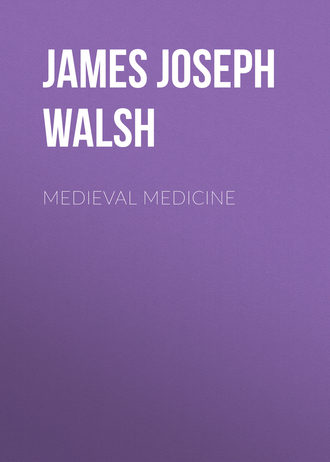 полная версия
полная версияMedieval Medicine
The bladders of animals were very commonly used by these Moorish physicians and by their disciples, and the profession generally, for generations, for a great many purposes for which we now use rubber bags. Abulcasis, for instance, used a sheep’s bladder introduced into the vagina and filled with air as a colpeurynter for supporting the organs in the neighbourhood, and also in fractures of the pubic arch.
Avenzoar suggested feeding per rectum in cases of stricture of the œsophagus, but he also treated the œsophageal stricture directly. He inserted a cannula of silver through the mouth until its head met an obstruction. This was pushed firmly, but withdrawn whenever there was a vomiting movement, until it became engaged in the stricture. Through it then freshly milked milk, or gruel made from farina or barley, was to be poured. He had evidently seen cases improve this way, and therefore must have had experience with functional stricture of the œsophagus. He adds that some physicians believe that nutrition may be absorbed through the pores of the whole body, and that therefore in these cases the patient might be put in a warm milk or gruel bath; but he has not very much faith in the procedure, and says that the reasons urged for it are weak and rather frivolous. It is easy to understand that a man who could recommend manipulative modes of treatment of such kinds, and discuss questions of nutrition so sensibly, knew his medicine very practically and wrote of it judiciously.
Maimonides (1135-1204) was one of these wise old Jews who quotes with approval from a Rabbi of old who had counselled his students: “Teach thy tongue to say, I do not know.” Knowing thus the limitations of his own knowledge, it is not surprising that Maimonides should have left a series of practical observations for the maintenance of health which represent the common sense of all time in the matter. Maimonides anticipated the modern rule for taking fruits before meals, as we all do now at breakfast, and so often as fruit cocktails at the beginning of other meals. He thought that grapes, figs, melons, should be taken before meals, and not mixed with other food. He set down as a rule that what was easily digestible should be eaten at the beginning of the meal, to be followed by what was more difficult of digestion. He declared it to be an axiom of medicine “that so long as a man is able to be active and vigorous, does not eat until he is over full, and does not suffer from constipation, he is not liable to disease.”
Salerno’s influence was felt much more deeply on surgery than on medicine, as can be seen very clearly from the chapter on Medieval Surgeons—Italy. These great surgeons of the period were also the leaders in medicine—for almost needless to say, there was no separation between the two modes of practice—men were as a rule both physicians and surgeons, even though for us their most important work by far was done in surgery. Certain passages from the works of these great surgeons that have come down to us deserve a place in the treatment of the more distinctly medical questions of the time.
Lanfranc the great French surgeon’s description of the treatment of the bite of a rabid dog is interesting. He suggests that a large cupping-glass should be applied over the wound, so as to draw out as much blood as possible. After this the wound should be dilated and thoroughly cauterized to its depths with a hot iron. It should then be covered with various substances that were supposed “to draw,” in order as far as possible to remove the poison. His description of how one may recognize a rabid animal is rather striking in the light of our present knowledge, for he seems to have realized that the main diagnostic element is a change in the disposition of the animal, but above all a definite tendency to lack playfulness. Lanfranc had manifestly seen a number of cases of true rabies, and describes and suggests treatment for them, though evidently without very much confidence in the success of the treatment.
The treatment of snake-bites and the bites of other animals supposed to be poisonous, or at least suspicious, followed the principles laid down for handling the bite of a mad dog. This was the case particularly as to the encouragement of free bleeding and the use of the cautery.
A characteristic example of the power of clinical observation of the medieval physicians, and one which illustrates much better than many of the absurd tales told as typical of their superstitious tendencies, but really representing that tendency always present in mankind to believe wonders, is to be found in how much they learned of rabies. Even in our own time there are many absurd beliefs with regard to this disease, with some denials of its existence and many grossly exaggerated tales, widely believed; yet the medieval people seem to have reached some quite rational notions with regard to it. Bartholomæus Anglicus is the author of a popular encyclopedia which was very widely read in the medieval period. He was an English Franciscan of the thirteenth century, who gathered together a lot of information and wrote a volume that for centuries after his time, even down to Shakespeare’s boyhood, was popular in England.
Here is his description of rabies as he knew it. The most important element is his recognition of the uncertainty of the length of the incubation period, but it contains two other ideas that are very interesting, because medicine in subsequent centuries has come back to them over and over again. One is that free bleeding may remove the virus, and the other that the cautery may help in preventing the infection.
“The biting of a wood-hound is deadly and venomous, and such venom is perilous. For it is long hidden and unknown, and increaseth and multiplieth itself, and is sometimes unknown to the year’s end, and then the same day and hour of the biting it cometh to the head, and breedeth frenzy. They that are bitten of a wood-hound have in their sleep dreadful sights, and are fearful, astonished, and wroth without cause. And they dread to be seen of other men, and bark as hounds, and they dread water most of all things, and are afeared thereof, full sore and squeamous also. Against the biting of a wood-hound wise men and ready use to make the wounds bleed with fire or with iron, that the venom may come out with the blood that cometh out of the wound.”
A very interesting development of therapeutics in the Middle Ages was the employment of the red light treatment to shorten the course and the severity of the fever in smallpox, and above all to prevent pitting; it was employed successfully by John of Gaddesden in the case of the son of King Edward II. Recent investigation by Cholmeley has shown that both Gilbertus Anglicus (1290) and Bernard de Gordon (1305) antedated John of Gaddesden in references to the red light treatment. All of these men were professors at Montpellier, showing that the medical school of the South of France was a rival in the use of natural methods of cure to its better-known predecessor of Southern Italy. Curiously enough, the “Rosa Anglica” of Gaddesden, in which the reference to the red light is made, is deservedly characterized by Garrison as “a farrago of Arabist quackeries and countrified superstitions”; it well deserves Guy de Chauliac’s bitter criticism of it as “a scentless rose.”
The idea included under the word autointoxication in our time—that is, that the human body has a tendency to produce poisons within itself, which act deleteriously on it and must be eliminated—was a favourite one during the Middle Ages. It became the custom in our time to have recourse to antiseptics or to surgical measures of various kinds for the relief and prevention of autointoxication. In the Middle Ages they thought to reduce its harmfulness at least by direct elimination, hence the use of drastic purgatives. It seems worth while remarking, however, that the employment of these did not come into general use until the close of the Middle Ages. Basil Valentine, if he really lived in the Middle Ages, and is not merely a name for a writer of the early sixteenth century, as modern historians seem inclined to think, suggested the use of antimony for the removal of the materies morbi from the body that has so much obsessed physicians for many generations. Antimony continued to be used down to the nineteenth century. It was gradually replaced by venesection, which was employed very strenuously during the eighteenth and early nineteenth centuries, in spite of the objection of such men as Morgagni, who refused to allow this mode of treatment to be used on him.
Venesection was succeeded by large doses of calomel, and the calomel era continued on almost to our own generation.
As a rule, however, the medieval physicians trusted nature much more than did their colleagues of modern history—that is, after the Renaissance until the present epoch of medical science began. It has always been difficult, however, for physicians to continue long in the persuasion that nature is a helpful auxiliary, and not a hampering factor to be combated. It is all the more to the credit of the medieval physicians to find, then, that in spite of many absurdities they continued for all the later centuries of the Middle Ages to extol the value of the natural means of cure.
I shall have much to say of John of Ardern in the chapter on Medieval Surgeons of the West of Europe, but he deserves a place also in the chapter on Medicine. Ardern’s advice to patients suffering from renal disease, which is contained in a separate tract of his lesser writings with the title in an old English version of “The Governaunce of Nefretykes,” is extremely interesting, because it shows very clearly how long ago thoughtful physicians anticipated most of the directions that we now give such patients. Though we are inclined to think that any real knowledge of renal disease is quite modern, and above all has come since Bright’s time, this paragraph of Ardern’s shows how long before definite pathological knowledge had developed, careful clinical observation worked out empirically the indications of the affection. The paragraph is of special interest, because it contains the first reference to the possible danger that there may be for sufferers from kidney disease using the dark or red meats rather than the white meats. The tradition as to the distinction between the red and white meats has continued ever since his time, and though our modern chemistry does not enable us to find any such distinction between these substances as would justify the differentiation thus dwelt on, it has been maintained for no other reason that I have ever been able to find than because of the long years of tradition and clinical observation behind it.6
“Nefretykes must putte awey ire, hyghly and moche besynesse and almanere [business and all manner of] thynge that longeth to the soule saff [save] only joye.... They schulle forbere almanere metys that ben to grete of substaunse and viscous, as olde beeff that is myghtyly pooudryd and enharded with salt and also fressch porke but yf it lye in salt iiii dayes afore.... They mowe use grete wyne and the fflessch of calvys that ben soowkynge and also of all ffowlys saff thoo that ben of the lakys and dichys [dykes?] … and squamous ffyssches, i.e., fyssch of the rivere, of the stony waterys and rennynge ryveres and not of the standyne waterys and they schulle eschywe [eschew] almaner mete made of paast [pastries] and all bred that is dowgh bakene and all fatnesse. And they schulle use the reynes of te beeste other roste or sode. And in especiall he schall use a ffowl that is callyd Cauda tremula or Wagstertte [the wagtail, an English bird] other fressch or salte or bakene withoute drynesse ffor and it be drye it is nought woorth. And note that the use of the powdir or of the flessch of the Wagstertte avayleth gretly to breke the stone in the bladdere.”7
CHAPTER VI
MEDIEVAL SURGEONS: ITALY
Strange as it may seem, and quite contrary to the usual impressions in the matter, the most interesting department of the history of the medical science during the Middle Ages is that of surgery. Because of this fact we have to divide the subject into two chapters, one for the surgery of Italy, the other for the surgery of the rest of Europe.
We have two series of medieval textbooks which treat largely of surgical subjects in a thoroughly scientific and professional way. The first of these comes to us from the earlier centuries of the Middle Ages, when Greek classic influence on medicine and the medical sciences was on the wane; and the other set comes to us from the later Middle Ages, when the earlier Renaissance of Greek influence was just making itself felt in Europe. Both sets of books serve to show very well that the men of these times were not only deeply interested in the affections for which surgery can provide the only relief possible, but that they had reached very definite, indeed sometimes ultimate, solutions of a large number of the constantly recurring problems of surgery.
The greatest surprise of the whole range of medical history is that these medieval surgeons of both periods anticipated not a few of the surgical advances that we have been accustomed to think of as having been reserved for our time to make. Our knowledge of these details of the work of the medieval surgeons not only of the sixth and seventh centuries, but also of the thirteenth and fourteenth, is not founded on tradition, nor on a few scattered expressions which a modern medievalist might exaggerate, but on actual textbooks, which fortunately for us were reprinted as a rule during the Renaissance period, and have been preserved for us usually in a number of rather readily available copies. Most of them have been reprinted during the past generation, and have revolutionized our knowledge of the history of surgery; for these textbooks exhibit in detail a deep knowledge of surgical affections, a well-developed differential diagnosis, a thoroughly conservative treatment, and yet a distinct effort to give the patient every possible surgical opportunity for his life, compatible with reasonable assurance of successful surgical intervention. As I have pointed out, the surgical history of the old Crusades was as interesting and almost as valuable for civil surgery as that of our own Great War.8
Three writers whom we have already mentioned (Early Medieval Medicine)—Aëtius, Alexander of Tralles, and Paul of Ægina—were, as we have seen, all of them interested in surgery, and wrote very interestingly on that subject. It is, however, from the end of the Middle Ages—that is, from the writers of the twelfth century down to the end of the fifteenth—that surprising contributions were made to surgical knowledge. This surgery of the end of the Middle Ages began its development at Salerno. The first great textbook was that of Roger—known also as Rogero and Ruggiero, with the adjective Parmensis or Salernitanus, of Parma or Salerno—who wrote his work about 1180. It is of this that Gurlt, in his “History of Surgery,” vol. i., p. 701, says: “Though Arabian works on surgery had been brought over to Italy by Constantine Africanus a hundred years before Roger’s time, these exercised no influence over Italian surgery in the next century, and there is scarcely a trace of the surgical knowledge of the Arabs to be found in Roger’s works.” He insisted, further, that Arabisms are not found in Roger’s writings, while many Græcisms occur. The Salernitan School of Surgery drank, then, at the fountain-head of Greek surgery.
After Roger comes Rolando, his pupil, who wrote a commentary on his master’s work, and then the combined work of both of them was subsequently annotated by the Four Masters. It is this textbook, the work of many hands and the combined experience of many great teachers, that is the foundation stone of modern surgery. Some of the expressions in this volume will serve to give the best idea of how thoroughly these surgeons of the later medieval period studied their cases, how careful they were in observation, and how well they solved many problems that we are inclined to think of as having come up for serious consideration only much later than this time. After studying their chapter on Injuries of the Head, it is easy to understand why Gurlt should declare that, though there is some doubt about the names of the authors, this volume makes it very clear that these writers drew their opinions from a rich experience.
They warn about the possibility of fracture of the skull even when there is no penetrating wound of the scalp, and they even suggest the advisability of exploratory incision when there is some good reason for suspicion of, though no evident sign of, fracture. In “Old-Time Makers of Medicine,” I quoted some of the details of this teaching as to head surgery that may serve to illustrate what these surgeons taught on this important subject.
There are many warnings of the danger of opening the skull, and of the necessity for definitely deciding beforehand that there is good reason for so doing. How carefully their observation had been made, and how well they had taken advantage of their opportunities, which were, of course, very frequent in those warlike times when firearms were unknown, hand-to-hand conflict common, and blunt weapons were often used, can be appreciated very well from some of the directions. For instance, they knew of the possibility of fracture by contrecoup. They say that “quite frequently, though the percussion comes in the anterior part of the cranium, the cranium is fractured on the opposite part.” They even seem to have known of accidents such as we now discuss in connection with the laceration of the middle meningeal artery. They warn surgeons of the possibilities of these cases. They tell the story of “a youth who had a very small wound made by a thrown stone, and there seemed no serious results or bad signs. He died the next day, however. His cranium was opened, and a large amount of black blood was found coagulated about his dura mater.”
There are many interesting things said with regard to depressed fractures and the necessity for elevating the bone. If the depressed portion is wedged, then an opening should be made with the trephine, and an elevating instrument called a spatumen used to relieve the pressure. Great care should be taken, however, in carrying out this procedure, lest the bone of the cranium itself, in being lifted, should injure the soft structures within. The dura mater should be carefully protected from injury as well as the pia. Care should especially be exercised at the brow, and the rear of the head, and at the commissures (proram et pupim et commissuras), since at these points the dura mater is likely to be adherent. Perhaps the most striking expression, the word “infect” being italicized by Gurlt, is: “In elevating the cranium, be solicitous lest you should infect or injure the dura mater.”
While these old-time surgeons insisted on the necessity for treating all depressed fractures, and even suggested that many fissure fractures required trephining, they deprecated meddlesome surgery of the cranium, unless there was evident necessity, quite as much as we do now. Surgeons who in every serious wound of the head have recourse to the trephine must, they said, be looked upon as fools and idiots (idioti et stolidi). When operations were done on the head, cold particularly was to be avoided. The operations were not to be done in cold weather, and above all not in cold places. The air of the operating-room must be warmed artificially. Hot plates should surround the patient’s head while the operation was being performed. If this were not possible they were to be done by candlelight, the candle being held as close as possible in a warm room. They had many experiences with fractures at the base of the skull. Hæmorrhages from the mouth and nose and from the ears were considered a bad sign. They even suggested, for diagnostic purposes, what seems to us the rather dangerous procedure that the patient should hold his mouth and nostrils tight shut and blow strongly. One of their methods of negative diagnosis for fractures of the skull was that, if the patient were able to bring his teeth together strongly, or to crack a nut without pain, then there was no fracture present. One of the commentators, however, adds to this, as well he might, sed hoc aliquando fallit—“but this sign sometimes fails.” Split or crack fractures were also diagnosticated by the methods suggested by Hippocrates of pouring some coloured fluid over the skull after the bone was exposed, when a linear fracture would show by coloration. The Four Masters suggest a sort of red ink for this purpose.
One might well expect that, with trephining as frequent as this textbook of the Four Masters more than hints, the death-rate of these medieval surgeons must have been very high in head cases. We can scarcely understand such intervention in the conditions of operation assumed to exist in the Middle Ages without almost inevitable infection and consequent death. They seem to have come to an empiric recognition of the advantage of absolute cleanliness in such operations. Indeed, in the light of our modern asepsis and its development during our own generation, it is rather startling to note the anticipation of what is most recent in the directions that are given to a surgeon to be observed on the day when he is to do a trephining. I give it in the original Latin as it may be found in Gurlt (vol. i., p. 707): “Et nota quod die illa cavendum est medico a coitu et malis cibis æra corrumpentibus, ut sunt allia, cepe, et hujusmodi, et colloquio mulieris menstruosæ, et manus ejus debent esse mundæ, etc.” The directions are most interesting. The surgeon’s hands must be clean; he must avoid coitus and the taking of food that may corrupt the air, such as onions, leeks, and the like; must avoid menstruating women; and in general must keep himself in a state of absolute cleanliness.
After the South Italian surgeons, some of whom taught at Bologna, a group of North Italian surgeons, most of whom probably were either direct or indirect pupils of the Salernitan School, must be considered. This includes such distinguished names in the history of surgery as Bruno da Longoburgo, usually called simply Bruno; Theodoric and his father Hugh of Lucca; William of Salicet; Lanfranc, the disciple of William who taught at Paris, and gave that primacy to French surgery which was maintained all the centuries down to the nineteenth (p. 1); and Mondino, the author of the first manual on dissection, which continued for two centuries to be used by practically everyone who anywhere did dissection throughout Europe. Practically all of these men did their best work between 1250 and 1300. Bruno of Longoburgo taught at Padua and Vicenza, and his textbook, the “Chirurgia Magna,” was completed in Padua in January, 1252. Gurlt notes that “He is the first of the Italian surgeons who besides the Greeks quotes also the Arabian writers on surgery.” Eclecticism had definitely come into vogue to replace exclusive devotion to the Greek authors, and men were taking what was good wherever they found it.
Bruno begins his work by a definition of surgery, chirurgia, tracing it to the Greek and emphasizing that it means handwork. He then declares that it is the last instrument of medicine to be used, only when the other two instruments, diet and potions, have failed. He insists that surgeons must learn by seeing surgical operations, and watching them long and diligently. They must be neither rash nor over-bold, and should be extremely cautious about operating. While he says that he does not object to a surgeon taking a glass of wine, the followers of this specialty must not drink to such an extent as to disturb their command over themselves, and they must not be habitual drinkers. While all that is necessary for their art cannot be learned out of books, they must not despise books, however, for many things can be learned readily from books, even about the most difficult parts of surgery. Three things the surgeon has to do—“to bring together separated parts, to separate those that have become abnormally united, and to extirpate what is superfluous.”
While the old textbooks had emphasized the necessity for not allowing the circulation in the head to be disturbed by the cold, and insisted on the taking of special precautions in this matter, Bruno insists that wounds must be more carefully looked to in summer than in winter, because “putrefaction is greater in warm than in cold weather”—putrefactio est major in æstate quam in hyeme. He is particularly insistent on the necessity of drainage. In wounds of the extremities the limb must always be so placed as to encourage drainage. To secure it the wound may be enlarged; if necessary, even a counter-opening must be made to provide drainage. In order to secure proper union care must be exercised to bring the wound edges accurately together, and not allow hair or oil or dressings to come between them. In large wounds he considers stitching indispensable, and the preferable suture material in his experience is silk or linen. He discusses healing by first and second intention, and declares that with proper care the healing of a great many wounds by first intention can be secured. All his treatment of wounds is dry. Water he considered always did harm, and it is quite easy to understand that his experience taught him this, for the water generally available for surgeons in camps and battlefields and in emergency surgery was likely to do much more harm than good.







